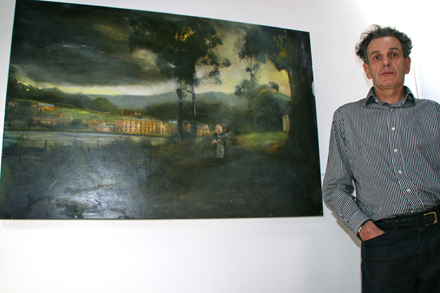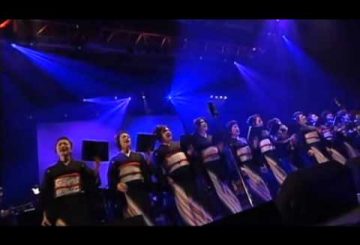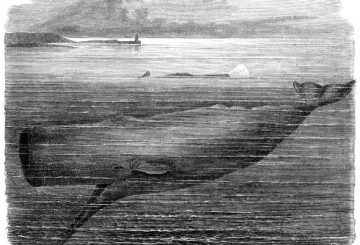Guest blogger Zoe Harrington takes another look at the Pople controversy and adds a little context…
Rodney Pople’s Glover Prize winning landscape painting, ‘Port Arthur‘, has incited a storm of criticism against the artist for its depiction of Martin Bryant, the murderer behind the Port Arthur Massacre. Pople has been accused of immortalising and glorifying the murderer. However his painting refers to the tragedy that Bryant’s name is synonymous with Port Arthur; and that his figure is forever burned on the landscape, and on the minds of all Australians.
It is not the first time that an artist has been criticised for depicting murderers and controversial figures. Sam Leach was in trouble in 2008 for his Archibald entry depicting himself as Hitler. He presented himself in Hitler’s uniform, smiling down from the painting. In Leach’s statement defending the work, he said: “Personally, as a white Australian, I inherit this Western European cultural tradition and the one of the products of that tradition was Nazism. In a nutshell, what I’m trying to say is that I think that we can’t take for granted that Nazism can’t happen again essentially.” Compared with the reaction to the Pople painting, Leach barely got a slap on the wrist for portraying one of history’s greatest monsters. The artist, Ron English, renowned for his controversial appropriations of advertising billboards, has also stirred society by depicting Charles Manson and Hitler in mock advertisements for Apple computers. Again, the artist’s choice to include these historical figures is derived from their continuing relevance in contemporary society. In an interview I did with him in 2010, he said, “At the time it seemed odd for a company to be obtaining the endorsements of mostly dead celebrities. I just filled in a few characters they overlooked. ”
English’s work depicting Manson is a good parallel with Pople’s work, as both feature contemporary murderers. English’s work could be viewed as being more offensive than Pople’s, however the majority of society has responded to the former’s work with humor. Of course humor was not the desired response by Pople, but it is interesting that his work has incited fury and calls for censorship; as well as suggestions that he donate his prize money. Why are some murderers more palatable than others? The reason of course is that we are used to images of war and devastation in faraway places: this image upsets us the most because it happened at home. The mob has double standards.
It is obvious that portraying a controversial figure in art will attract attention and incite furious debate over the ethics of such an act. But people do not speak in hushed tones about Hitler, Mussolini or Genghis Kahn– they are inevitable subjects of conversation- so why are we trying to censor artists? Everyone wants to forget the murderer Martin Bryant and wipe his memory from our history. Pople’s work illustrates, however, how impossible this task is.
The Glover prize is the ‘richest’ landscape painting prize in Australia and is awarded to the work judged to be ‘the best contemporary painting of the Tasmanian landscape’. Pople’s painting presents the landscape as being more than just bucolic beauty. It expresses the idea that our darkest histories are indelible stains on our landscape- its scars. This is reminiscent of Rover Thomas‘s paintings of the massacres of the Australian Aboriginal people, such as occurred at the Texas Downs Station. ‘In his (Thomas’) canvases the landscape is the witness to the atrocities, bearing the marks of history’. Pople in essence has done exactly the same thing.
Pople has stated: “He (Bryant) is sort of fading into the distance compared to the power of the whole landscape but he is part of it. I am not in any way glorifying Martin Bryant but to ignore it is looking in the wrong way as well.”
In an age when mob rule determines the fate of many people in the public eye who have caused offence, I am relieved to see the defence of the judges against the torrent of abuse directed toward Pople. It seems that our brand of anarchy created by YouTube, Facebook and Twitter where the fate of someone is determined by their popularity and therefore the revenue they bring in, has not overwhelmed the art world quite yet. However, if the sponsors withdraw as a consequence of this controversy, then the integrity of the prize may be challenged in subsequent years.
Of course people are only defending their sense of morality. It is the morality, however, of the status quo and the status quo generally wins. In the context of our commercial world, it is not what’s right, but what is profitable.
If this work is to be removed from society, then all works similar in nature should be treated equally. If this were to occur, the world’s collection of art would become considerably sparse.
I would like to end on a quote by Nietzsche from ‘Beyond Good and Evil’:
“There are moralities which are intended to justify their authors before others; other moralities are intended to calm him and make him content with himself; with others he wants to wreak vengeance, with others hide himself, with others transfigure himself and set himself on high; this morality serves to make its author forget, that to make him or something about him forgotten; many moralists would like to exercise power and their creative moods on mankind… “.




Hi Zoe. I’ve also written an opinion piece about the Pople painting on this website. And I also oppose its censorship. In a further coincidence, I’m also acquainted with the philosophy of Nietzsche. It seems we have quite a bit in common.
Despite these similarities, I feel the need to take issue with what I perceive to be one of the many category errors in your account of the ‘controversy’ surrounding Pople’s painting. It is logically false to claim any equivalence between a very recent act of arbitrary mass murder by a mentally disturbed individual and the systematic massacres of Aboriginal people that you refer to. People’s responses to representations of these ‘histories’ are necessarily different.
In the first case, people are not simply trying to deny ‘history’ in the way they have in the latter. An analogy may help here. A rape victim who doesn’t wish to see the image of his/her offender being circulated in the media is not ‘in denial’; he/she reports on feeling re-traumatised; on the other hand, discourses around rape that run counter to what you call the ‘mob’ or ‘status quo’ position may are, indeed, sometimes repressed because of a need to deny uncomfortable truths.
Of course, some who call for the censorship of Pople’s painting are not offended because of a particularly sensitivity to the violent crimes committed by Bryant, but are part of the ‘mob’ mentality that coalesces around these sorts of anxieties about images.
But I strongly believe that the way forward is not to dismiss all concerns with images as indicative of a herd morality and then make universalising claims about the value of art, but rather to look at them on a case-by-case basis. As someone who quotes ‘Beyond Good and Evil’, I’m confident you’d also see the value in this ethics over morality approach.
Hi Carrie, I enjoyed your response thoroughly and I am over joyed that you are also acquainted with Nietzsche. I read your opinion piece and what we have in common is that we both believe, in the Barthian sense, that the meaning of the work is not bound exclusively to the artist’s intention but understood according to its context. But that is where the similarities end.
I am tired of a public that reacts without being properly informed. Yes the meaning of a work cannot be completely controlled by the artist, but as you will know from our observance of conceptual art, that Barthes view that the artist is dead, is not always relevant. The audience has a shoot first, ask questions later response which leads, and I apoligise for using this term which seems so abhorrent to you, to an execution mob style response.
My article was highlighting that there is a major discrepancy in terms of the way the public views works depicting murderers in contemporary history, and also its major atrocities.
You are correct in stating that no two massacres are alike, of course that was not what I was suggesting. The Rover Thomas paintings and Pople’s painting are landscapes. Both refer to atrocities as being ‘scars on the landscape’. I was not likening the method or intention behind the massacres as you so clumsily asserted. In people’s minds, Port Arthur is directly associated with the massacre, suggesting that the place is indelibly marked, ‘scarred’ by the atrocity. That was my point.
I did however, parallel Charles Manson and Martin Bryant as being two mentally disturbed murderers who have been depicted in art. I also mentioned Hitler, whose representation is terribly offensive to people affected by the holocaust. I wanted to demonstrate the contrasting responses by the public to these works.
I was not suggesting a ‘denial’, as in the case of the history of the aboriginal massacres. I am sure that no one would deny that the Port Arthur massacre did occur. I stated that people want to ‘forget’- to never think of it again, which is completely different from denying that it ever happened. However, Pople’s work suggests that we cannot forget, that even the landscape remembers the massacre.
Your parallel between a rape victim and the massacre is invalid in this context. A rape victim is a single person, the rape therefore effects them alone. The Port Arthur massacre affected the entire nation. It affects the way we think of ‘Port Arthur’. I disagree with your view of Pople’s painting as being him parading a murderer all over the media, re-wounding those directly affected by Bryant. Instead, his work suggests a shared pain. The extreme response by the public confirms this.
I was not suggesting either, a universal condoning of art. I would simply like people to make an informed opinion- rather than one made from anger. I want people to be aware of the contradictions in terms of their reactions to works: why are some works condoned and others aren’t? I am very conscious of the problem of a growing form of anarchy derived from this social media saturated society. An assault by the public can lead to withdrawals of funding by sponsors. I am aware of your problem with my use of the term ‘mob’ but that is exactly what it is- when the public, with their onslaught of wrath, can direct the course of things without properly being informed. I want people to think, to be cautious rather than to dictate with a medieval-type execution mob mentality.
In the spirit of those with some faith left in structural linguistics, I’d like to end with a quote from the great English philosopher, Dick Emery: “Oh, you are awful, but I like you!”
I think this is not from an artist, nor a person that comprehended how it should be depicted, if at all reproduced. The intelligence of the artist has not been employed if it exists at all. Effing boring. Give up